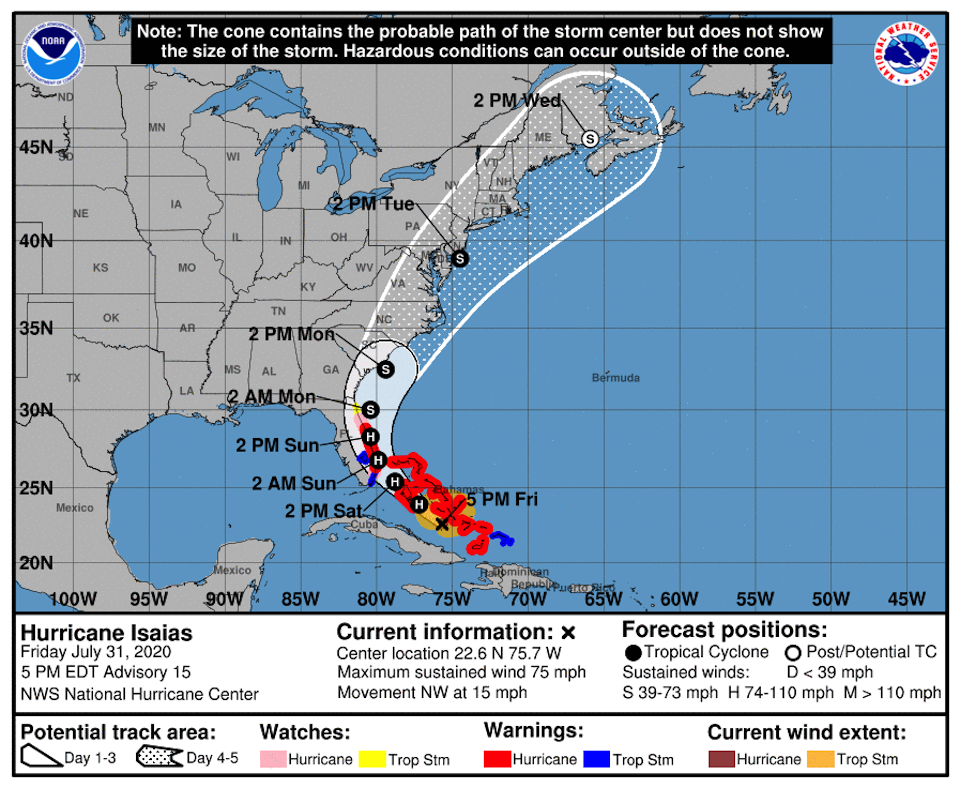
National parks from Florida to North Carolina were either closed or planning to close ahead of Hurricane Isaias/National Hurricane Center
National parks from Florida north into North Carolina began to close Friday, or were making preparations to close, ahead of Hurricane Isaias.
Everglades and Biscayne national parks both were closing Friday evening, while Cape Lookout National Seashore on the Outer Banks of North Carolina planned to shutter Saturday.
Everglades planned to temporarily close park entrances and visitor facilities at 7 p.m. Friday, while Biscayne National Park closed island visitor facilities and administrative facilities at 5 p.m.
"Marine waters will remain open for boating, but emergency services will be extremely limited after Friday," a release from Everglades said. "No wilderness camping permits will be issued until further notice.
"Vessels may seek safe harbor in the area of Ponce De Leon Bay, the Little Shark River between marker 1 and marker 69, and the main tributary of the Shark River," the release added. "The Flamingo Marina will be closed. Chickees are also closed and vessels are not permitted to tie off to chickees."
At Biscayne, staff said boaters could remain in park waters, including the Intracoastal Waterway and other channels. However, they were urged to monitor VHF radio for weather conditions and follow marine advisories.
Parks in coastal areas of Florida, Georgia, South Carolina, and North Carolina were implementing their severe weather plans and preparing for possible impacts this weekend.
At Cape Lookout National Seashore, staff planned to close the park Saturday in advance of Hurricane Isaias, which is expected to make landfall on the Outer Banks on Monday.
Isaias currently is expected to make a glancing blow to Florida's east coast on Saturday afternoon before running up the East Coast. It's forecast to make landfall on the Outer Banks by Monday afternoon as a category 1 hurricane with winds around 80 mph, the park said in a release, adding that there is a possibility that the track could shift east or west as the storm moves north from Florida.
Under the current forecast, the national seashore planned the following closures:
- Cape Lookout National Seashore will close at 3 p.m. EDT on Saturday.
- The Harkers Island Visitor Center will close at noon EDT on Saturday.
- The Keepers Quarters Museum was closed Friday.
- The Light Station Visitor Center (South Core Banks) will close at 3 p.m Saturday.
- Island Express Ferry Service (IEFS) will run as normal from Harkers Island on Saturday, but will be closed Sunday, August 2. IEFS’s service from Beaufort is closed as of Friday through at least Tuesday. Call Island Express Ferry Service for more information, 252-728-7433.
- Great Island Cabin Camp will close at 10 a.m. EDT on Saturday.
- Reservations at Great Island Cabin Camp are cancelled from Saturday through Friday, with additional closure beyond this timeframe pending the storm’s arrival and impacts.
- Visitors with upcoming reservations should monitor the weather conditions. Cancelled reservations due to weather will be issued a full refund at www.recreation.gov, or call (877) 444-6777.
- Visitors with vehicle ferry reservations may call their respective ferry for more information regarding schedule and/or reservations at the following: For visitors heading to North Core Banks - Morris Marina (Atlantic, NC; (252) 225-4261), and for visitors heading to South Core Banks -Cape Lookout Cabins and Camps Ferry Service (Davis, NC; (252) 729-9751), or Davis Shore Ferry (Davis, NC; (252) 729-3474).
Though expected to reach Cape Lookout as a category 1 hurricane, Isaias could do substantial damage to the national seashore.
Last September another hurricane, Dorian, made landfall at Cape Hatteras National Seashore just north of Cape Lookout as a category 1 storm. Dorian spawned a 9-foot wall of water that swept across the northern end of Cape Lookout, swamping historic Portsmouth Village, and slicing up the seashore's barrier islands into islets.
While Cape Lookout's three barrier islands -- North Core Banks, South Core Banks, and Shackleford Banks -- stretch 56 miles, the hurricane carved more than 50 breaches into those islands, or roughly one every mile. It took months for the national seashore to recover.









Add comment